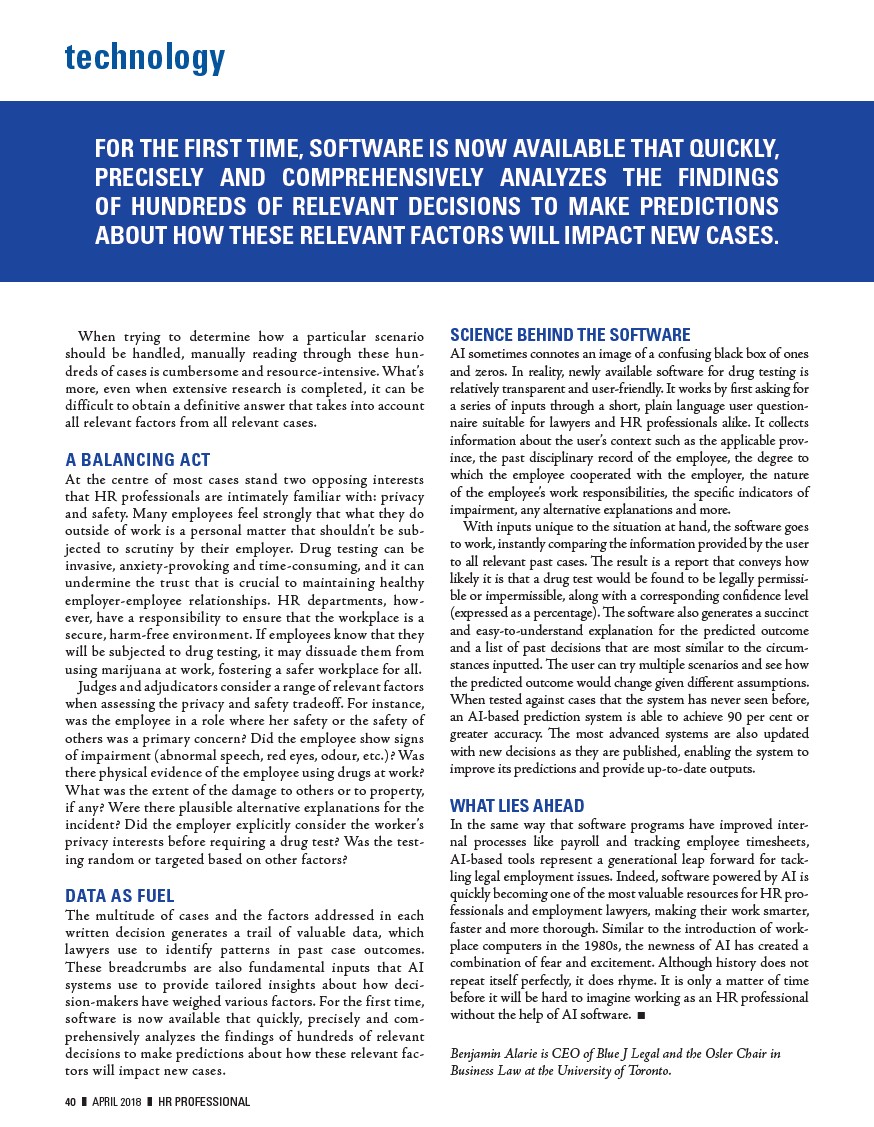
When trying to determine how a particular scenario
should be handled, manually reading through these hundreds
of cases is cumbersome and resource-intensive. What’s
more, even when extensive research is completed, it can be
difficult to obtain a definitive answer that takes into account
all relevant factors from all relevant cases.
A BALANCING ACT
At the centre of most cases stand two opposing interests
that HR professionals are intimately familiar with: privacy
and safety. Many employees feel strongly that what they do
outside of work is a personal matter that shouldn’t be subjected
to scrutiny by their employer. Drug testing can be
invasive, anxiety-provoking and time-consuming, and it can
undermine the trust that is crucial to maintaining healthy
employer-employee relationships. HR departments, however,
have a responsibility to ensure that the workplace is a
secure, harm-free environment. If employees know that they
will be subjected to drug testing, it may dissuade them from
using marijuana at work, fostering a safer workplace for all.
Judges and adjudicators consider a range of relevant factors
when assessing the privacy and safety tradeoff. For instance,
was the employee in a role where her safety or the safety of
others was a primary concern? Did the employee show signs
of impairment (abnormal speech, red eyes, odour, etc.)? Was
there physical evidence of the employee using drugs at work?
What was the extent of the damage to others or to property,
if any? Were there plausible alternative explanations for the
incident? Did the employer explicitly consider the worker’s
privacy interests before requiring a drug test? Was the testing
random or targeted based on other factors?
DATA AS FUEL
The multitude of cases and the factors addressed in each
written decision generates a trail of valuable data, which
lawyers use to identify patterns in past case outcomes.
These breadcrumbs are also fundamental inputs that AI
systems use to provide tailored insights about how decision
makers have weighed various factors. For the first time,
software is now available that quickly, precisely and comprehensively
analyzes the findings of hundreds of relevant
decisions to make predictions about how these relevant factors
will impact new cases.
SCIENCE BEHIND THE SOFTWARE
AI sometimes connotes an image of a confusing black box of ones
and zeros. In reality, newly available software for drug testing is
relatively transparent and user-friendly. It works by first asking for
a series of inputs through a short, plain language user questionnaire
suitable for lawyers and HR professionals alike. It collects
information about the user’s context such as the applicable province,
the past disciplinary record of the employee, the degree to
which the employee cooperated with the employer, the nature
of the employee’s work responsibilities, the specific indicators of
impairment, any alternative explanations and more.
With inputs unique to the situation at hand, the software goes
to work, instantly comparing the information provided by the user
to all relevant past cases. The result is a report that conveys how
likely it is that a drug test would be found to be legally permissible
or impermissible, along with a corresponding confidence level
(expressed as a percentage). The software also generates a succinct
and easy-to-understand explanation for the predicted outcome
and a list of past decisions that are most similar to the circumstances
inputted. The user can try multiple scenarios and see how
the predicted outcome would change given different assumptions.
When tested against cases that the system has never seen before,
an AI-based prediction system is able to achieve 90 per cent or
greater accuracy. The most advanced systems are also updated
with new decisions as they are published, enabling the system to
improve its predictions and provide up-to-date outputs.
WHAT LIES AHEAD
In the same way that software programs have improved internal
processes like payroll and tracking employee timesheets,
AI-based tools represent a generational leap forward for tackling
legal employment issues. Indeed, software powered by AI is
quickly becoming one of the most valuable resources for HR professionals
and employment lawyers, making their work smarter,
faster and more thorough. Similar to the introduction of workplace
computers in the 1980s, the newness of AI has created a
combination of fear and excitement. Although history does not
repeat itself perfectly, it does rhyme. It is only a matter of time
before it will be hard to imagine working as an HR professional
without the help of AI software. n
Benjamin Alarie is CEO of Blue J Legal and the Osler Chair in
Business Law at the University of Toronto.
technology
FOR THE FIRST TIME, SOFTWARE IS NOW AVAILABLE THAT QUICKLY,
PRECISELY AND COMPREHENSIVELY ANALYZES THE FINDINGS
OF HUNDREDS OF RELEVANT DECISIONS TO MAKE PREDICTIONS
ABOUT HOW THESE RELEVANT FACTORS WILL IMPACT NEW CASES.
40 ❚ APRIL 2018 ❚ HR PROFESSIONAL